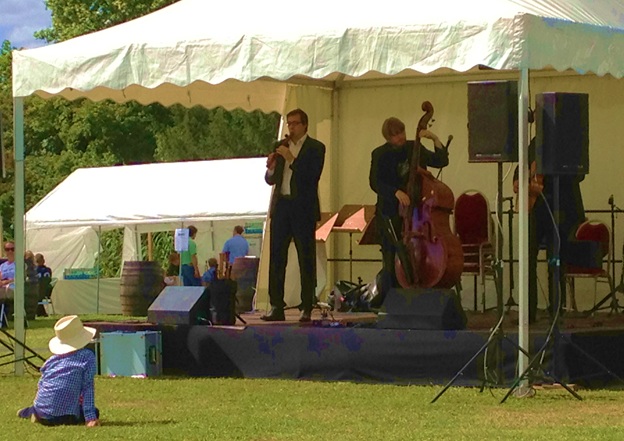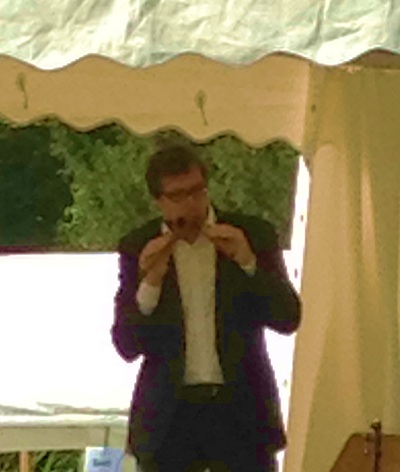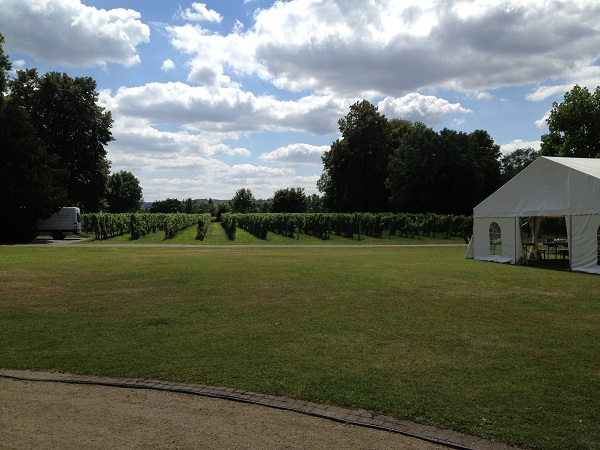
D rei Musiker - eine Mission: Die Befreiung der Blockflöte vom schäbigen Ruf eines Kinderspielzeugs! [Three musicians, one mission: Liberation of the recorder from its seedy reputation as a children’s toy!]”
— Wildes Holz.
S ometimes an event is just so good you have to pinch yourself to check whether or not you are dreaming. That is surely the case for the ‘Musiker in Weingütern’ events, part of the Rheingau Festival near Frankfurt/Wiesbaden. The performance I attended yesterday at Weingut Baron von Knyphausen was full, approximately 2,000 people attending at 32 euro each = €64K ticket sales, plus concession sales.
S eating was at well-shaded picnic tables with benches seating 8 persons per bench, 16 persons per table. The picnic tables were arranged under a U-shaped configuration of large wind- and weather-proof tents, with the stage in the center of the U. On each side of the U, the tables were deployed with their long axis pointing toward the stage. The grass aisles between adjoining tables were wide enough to enable attendees to quietly and easily come and go without disturbing their neighbors. Each table was numbered, and each numbered seat was assigned and ticketed—so that attendees purchasing tickets were able to select the location and price-level of seating they preferred, in just the same way as they would for a concert in a concerthall—with the assurance and peace-of-mind that they will not be subjected to a jostling free-for-all, of the sort that is associated with ‘general admission’ to a sold-out performance.
T he geometry of the tables and benches arranged in this manner meant that every member of the audience had one shoulder toward the stage (or else straddled the bench or rode the bench side-saddle to face the stage) and had a fine view of the performers throughout.
T he performance began at 16:00 sharp and continued until 20:00. Children played in the grassy space in front of the stage. Despite vigorous play, not once was there noise or rough-housing; not once did a parent have to collar a child to stop any misbehavior. The adults consumed generous quantities of wine but not one became loutish or disruptive. In short, a wonderful afternoon was had by all!

E ach of 4 ensembles played for 35 minutes with 25 minutes interval for set-up and sound-checks for the next group, during which the attendees had ample time to go to the concession tables and buy food, wine, and water. Sound reinforcement was expertly done, with excellent miking and engineering from the mixing deck, and sufficient monitor speakers arrayed all around the tent area.
T he tents and awnings were of extremely heavy-weight vinyl-coated materials, so that even in a 5km/hr light breeze they made absolutely no flapping or extraneous noise.
T o make this sort of a 4-hour collaboration succeed, the following elements are essential:
- Musical repertoire must be relatively robust (not ‘loud’ surely, but with tempi and phrasing that will be gesturally clear even under less-than-ideal acoustical conditions), so that the sound reinforcement will be adequate to enable the performers to be understood without listener annoyance, even if there is some wind.
- Musicians must possess abundant poise and confidence to face unexpected contingencies gracefully and with humor.
- Catering and front-of-house staff must be knowledgeable, skillful, and energetic in their roles. They must behave as though their employment depends on their performance. Presenters: Do not imagine attempting an event of this size and complexity with volunteer or trainee resources or staff who have a laid-back or entitlement attitude, or who cop a touchy ‘artistic temperament’ when they are in contact with the public.
- Food and beverage concessions must offer a menu with a wide variety of choices ranging from small snacks to mains and desserts, deliver them rapidly to customers (from steam-tables and other logistically efficient equipment), and handle cashier operations swiftly.
- Lavatory facilities should be dispersed throughout the periphery of the venue, so that access is quick and reasonably dignified for all attendees regardless of their seating location and queues do not form. Wineries are accustomed to catering large events with substantial ingress and egress of fluids and are expert in maintaining appealing aesthetics with these necessary functions. This is no time for cheap, smelly temporary johnny-on-the-spot sheds.
A n event like this has, I would say, approximately equal opportunities and risks for the winery and for the performers. The attendees and their word-of-mouth social network communications about their wine-music experience are a portal to viral opinions about both products—the wine and the music. Both products face intense competition and market-saturation. And, to be honest, both products tend to address market segments that are somewhat older—35 years and up. There should be more music-wine events like this! (There are a few, such as Music in theVineyards Festival in St. Helena, California, and Huntington Estate Festival in New South Wales.) But there is an unmet need here. There should be far more events like these! In summary, [chamber/small-ensemble] music-in-vineyards is a perfect blend, and Weingut Baron Knyphausen and the ensembles yesterday harmonized perfectly on this sunny Sunday in July, to the total pleasure and memorable benefit of all.

- Wildes Holz website
- Vano Bamberger Ensemble
- CriCri Brasil
- Frankfurt Swing All Stars
- Weingut Baron Knyphausen
- Rheingau Musik Festival
- Hall C, Mitchell R. Wine Marketing: A Practical Guide. Butterworth-Heinemann, 2007.
- Higgs D. Effective Tweeting For Wineries: A Guide to Wine Marketing on Twitter. ADS, 2012.
- Lapsley J, Moulton K. Successful Wine Marketing. Springer, 2001.
- Resnick E. Wine Brands: Success Strategies for New Markets, New Consumers and New Trends. Palgrave-Macmillan, 2008. (pp. 108ff on music tie-ins)
- Thach L. et al. Wine Marketing & Sales: Success Strategies for a Saturated Market. Wine Appreciation Guild, 2007.
- GreatWineCapitals.com
No comments:
Post a Comment